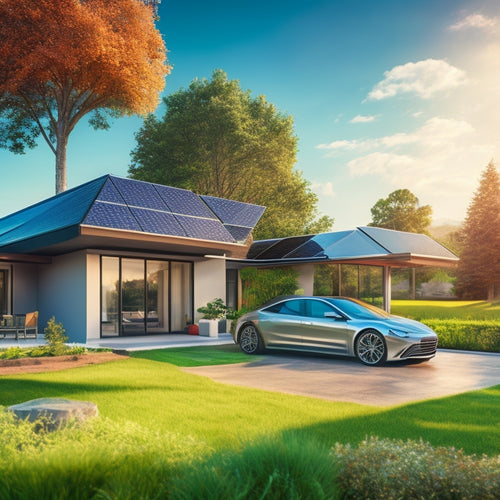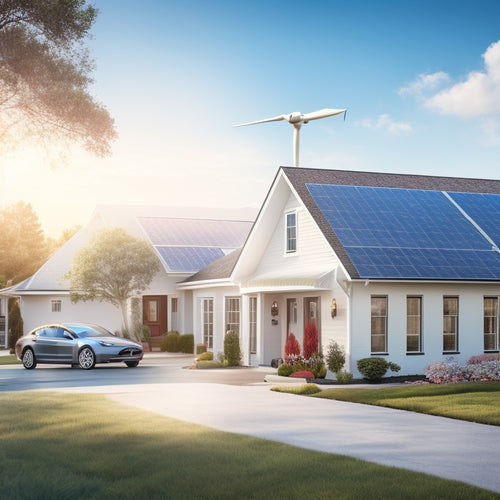
Sizing Solar Panels for Your Roof Space: 10 Tips
Share
You're looking to size your solar panel system perfectly for your roof space, ensuring it meets your energy needs. Start by calculating your daily energy requirements, considering your past electricity bills and energy consumption habits. Next, measure your roof's dimensions, accounting for obstacles like vents and skylights. Assess shading and obstacles, evaluate peak sun hours, and consider inverter efficiency. Don't forget to leave space for future expansion and consult a professional installer. By following these steps, you'll be well on your way to a tailored solar panel system. Now, discover how to tackle each of these essential steps in detail.
Key Takeaways
• Accurately measure your roof's length and width to determine available space for solar panels, considering obstacles like vents and skylights.
• Calculate your daily energy requirements in watt-hours to size your solar panel system correctly, ensuring it meets your energy needs.
• Evaluate the impact of shading and obstacles on your solar panel system's performance, using tools like shading simulations to visualize tree impact.
• Consider your roof's age, architecture, and complexity when planning your solar panel installation, ensuring a suitable and efficient setup.
• Leave space for future expansion and consider scalable systems, allowing you to adapt to changing energy needs and incorporate more efficient panels.
Assess Your Energy Requirements
To determine the ideal solar panel size for your roof, you need to calculate your daily energy requirements in watt-hours (Wh) by tracking your past electricity bills or using an energy monitoring device. This will give you a clear picture of your daily consumption habits. Think of it as an energy audit, but less intimidating than it sounds.
You're basically just trying to figure out how much energy you use on a daily basis. Now, you might be wondering why this step is important. Well, it's simple: you can't size your solar panels correctly if you don't know how much energy you need to produce. It's like trying to fit a puzzle piece without knowing the puzzle's dimensions – it just won't work.
Measure Your Roof's Dimensions
You'll need to grab your tape measure and head outside to accurately measure your roof's dimensions, including its length, width, and any obstacles like vents, skylights, or chimneys that could impact solar panel placement. Don't forget to take into account the age of your roof – an older roof might require more careful planning to make sure the solar panels can be securely fastened.
Take note of your roof's architectural style, too; for instance, a complex roofline with multiple peaks and valleys may need more sophisticated solar panel design.
Measure the length and width of each section of your roof, and identify any areas that might be partially shaded or obstructed. Make a sketch or drawing of your roof's layout, marking any obstacles or potential issues. This will help you visualize the space and plan your solar panel installation more effectively.
Remember to measure carefully and take your time – accurate measurements are essential for a successful solar panel installation. With your measurements in hand, you'll be able to move on to the next step: calculating the available space on your roof for solar panels.
Calculate Roof Space Availability
With your roof's dimensions and obstacles mapped out, calculate the total available space by subtracting the area occupied by vents, skylights, and chimneys from the roof's overall square footage. This step is essential in determining how many solar panels you can fit on your roof.
To do this, you'll need to perform an obstruction analysis, identifying any features that will limit your solar panel placement. Take note of the roof geometry, including the angles and orientation of your roof, as these will impact the placement of your solar panels.
Next, calculate the area of each obstacle, including vents, skylights, and chimneys, and subtract these from the total roof area. This will give you the total available space for your solar panels. Remember to account for any roof features that may impact solar panel placement, such as valleys, ridges, and hips.
Consider Shading and Obstacles
When sizing solar panels for your roof space, you'll need to take into account the impact of shading and obstacles on your system's performance.
You should evaluate how nearby trees will cast shade on your panels, as well as identify any roof obstacles like vents, skylights, or chimneys that may block sunlight.
Additionally, you'll want to assess the potential for nearby structures to overshadow your solar array.
Assessing Tree Shading Impact
As you analyze your roof's solar potential, consider the trees surrounding your property, as their shading impact can greatly reduce the energy output of your solar panel system. You might be thinking, 'Trees? Really? They're just providing some nice shade!' But trust us, those leafy friends can be energy-sucking foes.
To get a better grip on the situation, analyze the tree coverage patterns around your property. Take note of the tree types, their heights, and their proximity to your roof. This will help you identify potential shading hotspots.
Next, consider running shading simulations to visualize the impact of those trees on your solar panel system. These simulations can be done using specialized software or by consulting with a solar expert. By doing so, you'll get a clear picture of how much energy your system will produce and identify areas where tree trimming or removal might be necessary.
Don't let those trees cast a shadow on your solar dreams! By evaluating their impact, you'll be one step closer to optimizing your solar panel system's performance.
Roof Obstacles and Clearance
Identifying and addressing any shading or clearance issues on your roof's physical features and obstacles can greatly impact the performance of your solar panel system. You don't want any surprises down the line, like realizing your solar panels are constantly shaded by that chimney or skylight.
Take a closer look at your roof's obstacles and consider the following:
-
Vent Pipe Clearance: Make sure your solar panels have enough clearance around vent pipes to allow for easy maintenance and airflow.
-
Skylight Interference: Be mindful of skylights, as they can cast shade on your solar panels and reduce their efficiency.
-
Roof Feature Avoidance: Identify any other roof features that could interfere with your solar panel system, such as roof vents or antennas, and plan accordingly.
Nearby Structure Overshadowing
Assess the surrounding structures, including neighboring buildings, trees, and billboards, to determine if they'll cast shade on your solar panels and safeguard their energy output. You don't want any structural interference ruining your solar game! A Shadow Analysis will help you identify potential obstacles and determine the best placement for your panels.
Take note of the time of day and year when the sun is at its strongest. Will that tall oak tree cast a shadow on your roof during peak sun hours? How about that giant billboard on the adjacent building? You get the idea. Make a mental (or actual) map of the surrounding area to identify potential shading hazards.
Don't let nearby structures overshadow your solar ambitions! By considering these factors, you'll be able to optimize your solar panel placement and guarantee maximum energy output.
Determine Your Energy Goals
To determine your energy goals, you'll need to quantify your energy consumption by tracking your past electricity bills or using online tools that estimate energy usage based on your location and appliance usage. This will give you a clear picture of how much energy you need to produce to meet your daily needs.
Conducting an energy audit can help you identify areas where you can reduce your energy consumption, making it easier to achieve your renewable targets.
Here are some key considerations to keep in mind:
- Know your energy usage patterns: Are you a heavy user of energy-hungry appliances like air conditioners or electric water heaters?
- Set realistic targets: Aim to reduce your energy consumption by a certain percentage or achieve a specific level of energy independence.
- Consider your budget: Determine how much you're willing to invest in your solar panel system and set energy goals that align with your budget.
Choose the Right Panel Type
With your energy goals in mind, you're now ready to select the right solar panel type that will help you achieve them. You've got your energy goals nailed down, now it's time to find the perfect panel to match.
The key is to balance panel efficiency with your budget. Higher-efficiency panels might be more expensive, but they'll generate more power per hour of sunlight. Look for panels with high-efficiency ratings (around 20% or higher).
But don't break the bank just yet! Compare brands and models to find the sweet spot between efficiency and cost. Researching brands like Tesla, Panasonic, and SunPower will give you a solid starting point. When comparing brands, consider factors like warranty length, durability, and customer support.
Don't be afraid to get detailed and delve into the specs – it's worth it to find the perfect panel for your roof space. Remember, you're investing in a system that'll be generating clean energy for years to come. Choose wisely, and you'll be basking in the glow of solar savings in no time!
Calculate Peak Sun Hours
Identifying your location's peak sun hours is essential, as this metric directly impacts the energy output of your solar panel system.
You see, peak sun hours (PSH) measure the amount of solar irradiance your location receives, which affects how much energy your panels can produce.
When calculating PSH, you'll need to take into account your location's climate zone and the time of year. Here are a few key factors to keep in mind:
- Latitude and altitude: Areas closer to the equator receive more direct sunlight, while higher elevations receive more intense sunlight due to thinner air.
- Seasonal variations: Summer months typically receive more sunlight than winter months, so you'll want to calculate PSH for each season separately.
- Local obstructions: Trees, buildings, and other obstructions can reduce the amount of sunlight your panels receive, so be sure to factor those in.
Account for Inverter Efficiency
You've calculated your location's peak sun hours, now it's time to contemplate the efficiency of your inverter, which can greatly impact the overall performance of your solar panel system. Inverter efficiency ratings vary depending on the type, and selecting the right one for your setup is crucial.
| Inverter Type | Efficiency Rating |
|---|---|
| String Inverter | 95-98% |
| Microinverter | 90-95% |
| Power Optimizer | 97-99% |
As you can see from the table, string inverters and power optimizers tend to have higher efficiency ratings. Microinverters, on the other hand, have lower ratings but offer more flexibility in system design. When choosing an inverter, consider the type that best suits your system's requirements. Don't forget to check the manufacturer's specifications, as efficiency ratings can vary between models. Remember, a highly efficient inverter can make a significant difference in your system's overall performance. So, take your time, and choose wisely!
Leave Space for Future Expansion
When planning your solar panel installation, consider leaving some roof space unused to accommodate future upgrades or expansions. You never know when you might want to add more panels or upgrade to more efficient technology. Leaving some breathing room on your roof will future-proof your system, making it easier to adapt to changing energy needs.
Here are a few reasons why you should leave space for future expansion:
-
Future-proofing: Technology is constantly improving, and leaving space for future upgrades will allow you to take advantage of new, more efficient panels as they become available.
-
System scalability: As your energy needs change, having extra space on your roof will enable you to add more panels or upgrade to more powerful systems.
-
Increased flexibility: Leaving space for future expansion will give you the flexibility to adapt to changing energy demands, whether it's adding more panels for a growing family or upgrading to a more efficient system.
Consult a Professional Installer
With your roof space assessed and future expansion accounted for, now consult a professional installer to guarantee a seamless and efficient solar panel installation process. You've done your part; now it's time to bring in an expert to make sure your solar panel system is installed correctly and meets your energy needs.
When selecting an installer, make sure to check their credentials, including industry certifications like NABCEP (North American Board of Certified Energy Practitioners) or UL (Underwriters Laboratories). A reputable installer will have these certifications and be happy to provide references.
Here's a quick checklist to take into account:
| Installer Credentials | What to Look For |
|---|---|
| Industry Certifications | NABCEP, UL, or other recognized certifications |
| Experience | Number of years in business, number of installations completed |
| Reviews | Check online reviews, ask for references, and check their rating with the Better Business Bureau |
Frequently Asked Questions
Can I Install Solar Panels on a Metal or Tile Roof?
"You're wondering if you can install solar panels on a metal or tile roof? Absolutely! Modern solar panels can be securely fastened to most roof materials, including metal roofing, with specialized mounting systems, so go for it!"
How Do I Ensure My Solar Panels Are Bird-Proof?
You'll want to bird-proof your solar panels to prevent those pesky critters from nesting underneath and causing damage. Install bird deterrents like mesh screens or wildlife protection spikes to keep them away, ensuring a safe and efficient energy harvest.
Will Solar Panels Increase My Property's Resale Value?
You're wondering if solar panels will boost your property's resale value? Absolutely! They can increase your appraisal value and home equity, making your property more attractive to potential buyers - it's a bright idea, if you will!
Can I Install Solar Panels Myself, or Do I Need a Pro?
"Thinking of going solo with solar installation? Don't risk a DIY fiasco! Without expertise, you might void warranties or compromise safety. Opt for a pro's professional guarantee, ensuring a seamless, efficient, and safe installation – your roof (and nerves) will thank you!"
Are Solar Panels Resistant to Extreme Weather Conditions?
"Hey, you're wondering if solar panels can withstand Mother Nature's fury? Rest assured, they're designed to be weather durable and storm resistant, withstanding extreme temps, hail, and high winds, so you can relax and soak up the sun's energy!"
Related Posts
-

What Solar Panels Work Best With EVS Online?
When shopping for solar panels online to power your electric vehicle, look for high-efficiency models that can withst...
-

Why Homeowners Are Embracing DIY Energy Independence
By taking control of your energy needs, you're breaking free from the uncertainty of utility bills and embracing a se...
-

Why Cities Need Smart Charging Infrastructure Now
You're about to experience a tidal wave of electric vehicles hitting your city's streets, and it's essential you're p...


